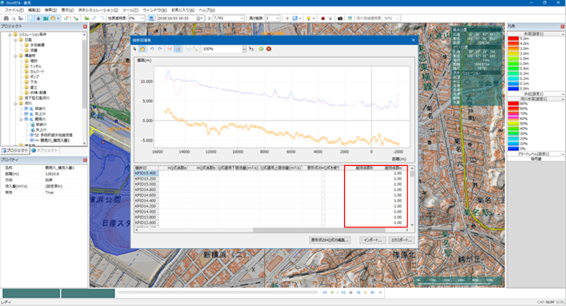FAQ/ Giving Rivers Overflow Coefficients¶
Can a river be given an overflow coefficient?
response¶
It's possible.
For each section, an overflow coefficient alpha and an overflow coefficient theta can be given.
 Figure D-6: Overflow coefficient setting screen
Figure D-6: Overflow coefficient setting screen
The overflow coefficient conforms to the formula of Kurishiro, etc. in the Flood Expected Area Drawing Manual (4th Edition).
Manual for Mapping Flood Areas (4th Edition) p. 16
3.1. Basic concept of flood analysis > (6) Calculation of flood flow rate from rivers > 1) Horizontal flow formula > (1) Formula of Kurishiro, etc.
The overflow flow rate \(Q_0\) according to the frontal overflow formula of Honma is formulated by correcting the direction angle \(\theta\) shown in Table 3.2-2 and the correction factor \(\alpha\), and the outflow angle and correction factor are represented by the riverbed gradient \(I\) (see Table 3.2-2).
表-3.2-2 横越流特性(栗城等より)
破堤氾濫
\(I > 1/1580\)
\(\alpha = 0.14 + 0.19 * \log10 (1/I)\),
\(\theta = 48 - 15 * \log10(1/I)\)
\(1/1580 \ge I > 1/33600\)
\(\alpha = 0.14 + 0.19 * \log10 (1/I)\)
\(\theta = 0\)
\(1/33600 \ge I\)
\(\alpha = 1\)
\(\theta = 0\)
溢水に伴う越流
\(I > 1/12000\)
\(\alpha = 1\)
\(\theta = 155 - 38 * \log10(1/I)\)
\(1/12000 \ge I\)
\(\alpha = 1\)
\(\theta = 0\)
For more information, refer to the Technical Reference Overflow coefficient setting function (alpha and theta) and overflow coefficient setting function for levees (alpha, thata).